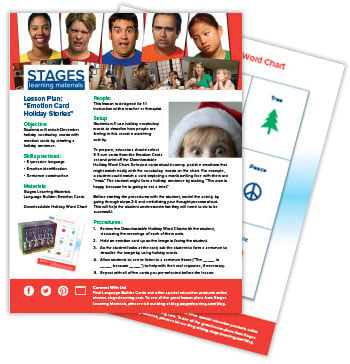Emotion Card Holiday Stories
Lesson Overview
Students will match December holiday vocabulary words with emotion cards by creating a holiday sentence.
Objectives/Goals
- Expressive language
- Emotion identification
- Sentence construction
Materials
Stages Learning Materials Language Builder: Emotion Cards
Downloadable Holiday Word Chart (included with downloadable lesson plan)People
This lesson is designed for 1:1 instruction with a teacher or therapist.
Setup
Students will use holiday vocabulary words to describe how people are feeling in this creative matching activity.
To prepare, educators should select 3-5 cue cards from the Emotion Cards set and print off the Downloadable Holiday Lesson Plan/Word Chart. Selected cards should convey positive emotions that might match easily with the vocabulary words on the chart. For example, a student could match a card depicting a man’s smiling face with the word “treat.” The student might form a holiday sentence by stating, “The man is happy because he is going to eat a treat.”
Before starting the procedures with the student, model the activity by going through steps 2-4 and verbalizing your thought process aloud. This will help the student understand what they will need to do to be successful.Procedures
-
Review the Downloadable Holiday Word Chart with the student, discussing the meanings of each of the words.
-
Hold an emotion card up so the image is facing the student.
-
As the student looks at the card, ask the student to form a sentence to describe the image by using holiday words.
-
Allow students to see or listen to a sentence frame (“The _____ is _____ because _____”) to help with their oral response, if necessary.
- Repeat with all of the cards you pre-selected before the lesson.

Additional Suggestions for Support
-
Visual sentence frames - Before engaging in the activity, create an “anchor chart,” or referenceable visual aid, with sentence stems that students can use to respond to your questions. Remember to review the sentence stems and model correct usage before engaging in the activity!
-
Provide choices - Should students struggle to identify what is taking place in the photo (emotion, occupation, noun, situation), remember that choices can provide additional support without “giving away” the answer. For example, if a student is unable to identify an emotion as “happy,” consider asking the student, “Is the person in the picture feeling sad?”
-
Echoing answers - If students are struggling to generate language to respond to your prompt, consider having students echo the correct answer by repeating after you. State the correct answer in 2-3 word phrases and ask the student to repeat after you. To increase difficulty, extend the length of repeated phrases. Remember to celebrate successes!
-
Meaningful motion - Incorporate physical gestures and movements to help students understand and generate language. Encourage students to mirror your movements in their responses.
-
Pre-teach vocabulary - Before your activity, don’t forget to pre-teach essential vocabulary to ensure students are equipped with the language required for success. Show students a visual image that represents the word and ask them to say the word after you. This support is especially important for language learners.
- Response drawings - Invite students to draw their responses instead of speaking them aloud as a way to help initiate the process of communication. After students have produced a drawing, prompt them to explain their creation by asking probing questions.

Marysa Sheren, M.Ed. Technology, Innovation, and Education
Marysa Sheren, M.Ed. Technology, Innovation, and Education, is a literacy teacher, former instructional coach and current graduate student in Technology, Innovation, and Education at the Harvard Graduate School of Education. After graduating from Tufts University in 2012 with a degree in Philosophy, she joined Teach For America Miami and began her career in education. She is passionate about designing for how people learn as well as strategically supporting the implementation of new technologies in traditional and non-traditional learning environments. Her work is driven by the belief that learning is a natural human state and that all learners have tremendous potential.





